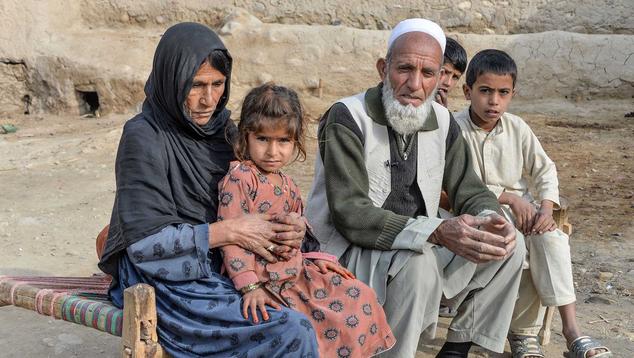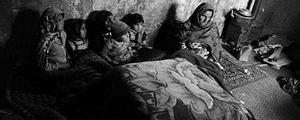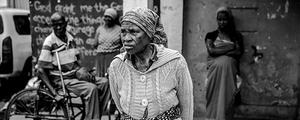Story Highlights
- 710 million out of 750 million highly vulnerable live in developing world
- Poorest in developed countries as highly vulnerable as the richest in developing countries
This article is the second in series based on results from Gallup's new Basic Needs Vulnerability Index.
WASHINGTON, D.C. -- Before the COVID-19 pandemic made life harder for almost everyone on the planet, Gallup analysis shows that three-quarters of a billion people worldwide were struggling to meet their basic needs and didn't have any family or friends to help in times of trouble.
While the highly vulnerable on Gallup's new Basic Needs Vulnerability Index exist in every country, most -- about 710 million out of the 750 million -- live in developing economies. The rest -- about 40 million -- live in developed economies.

Heat map. The heat map shows the range in the percentage of people around the world who fall into the High Vulnerability category on the Basic Needs Vulnerability Index. Percentages range from 1 percent to 50 percent.
Basic Needs Vulnerability Index
Gallup's Basic Needs Vulnerability Index gauges people's potential exposure to risk from economic and other types of shocks like a pandemic. Beyond measuring people's ability to afford food and shelter, this index also folds in whether people have personal safety nets -- people who can help them when they are in trouble.
People worldwide fall into one of three groups:
High Vulnerability: People in this group say there were times in the past year when they were unable to afford food or shelter or say they struggled to afford both and say they do not have family or friends who could help them in times of trouble.
Moderate Vulnerability: People in this group say there were times in the past year when they were unable to afford food or shelter or say they struggled to afford both, and they do have family or friends to help them in times of trouble.
Low Vulnerability: People in this group say there were not times in the past year when they struggled to afford food or shelter and say they do have family or friends to help them if they were in trouble.
Who Are the Highly Vulnerable?
Gallup finds people in the highly vulnerable group were potentially more at risk in almost every area of their lives before the pandemic, and of utmost importance amid the COVID-19 pandemic, particularly in regard to their health.
A closer look at who the highly vulnerable were in developed and developing economies reveals that, in a number of respects, they aren't as different as some might expect. For example, when it comes to health problems, among the highly vulnerable populations, almost the same percentage in developing economies (41%) and high-income economies (42%) reported having them.
In general, living in high-income economies offers more stability within populations. There are fewer major differences in the highly vulnerable group by gender or urbanicity in developed economies. However, relative wealth appears to act as a buffer to vulnerability in developed and developing economies alike.
The poorest 20% in both developed and developing economies were the most likely to be highly vulnerable, and this likelihood drops as income levels rise. Just 1% of the richest 20% of the populations in developed economies are highly vulnerable, compared with 9% of the poorest 20%. In developing countries, 8% of the richest 20% are highly vulnerable, compared with 24% among the poorest 20%.
Interestingly, those in the richest 20% in developing economies are as likely to be highly vulnerable as the poorest 20% in developed economies.
| Developed economies | Developing economies | |||||||||||||||||||||||||||||||||||||||||||||||||||||||||||||||||||||||||||||||||||||||||||||||||||
|---|---|---|---|---|---|---|---|---|---|---|---|---|---|---|---|---|---|---|---|---|---|---|---|---|---|---|---|---|---|---|---|---|---|---|---|---|---|---|---|---|---|---|---|---|---|---|---|---|---|---|---|---|---|---|---|---|---|---|---|---|---|---|---|---|---|---|---|---|---|---|---|---|---|---|---|---|---|---|---|---|---|---|---|---|---|---|---|---|---|---|---|---|---|---|---|---|---|---|---|---|
| % | % | |||||||||||||||||||||||||||||||||||||||||||||||||||||||||||||||||||||||||||||||||||||||||||||||||||
| Gender | ||||||||||||||||||||||||||||||||||||||||||||||||||||||||||||||||||||||||||||||||||||||||||||||||||||
| Men | 4 | 16 | ||||||||||||||||||||||||||||||||||||||||||||||||||||||||||||||||||||||||||||||||||||||||||||||||||
| Women | 4 | 17 | ||||||||||||||||||||||||||||||||||||||||||||||||||||||||||||||||||||||||||||||||||||||||||||||||||
| Income* | ||||||||||||||||||||||||||||||||||||||||||||||||||||||||||||||||||||||||||||||||||||||||||||||||||||
| Poorest 20% | 9 | 24 | ||||||||||||||||||||||||||||||||||||||||||||||||||||||||||||||||||||||||||||||||||||||||||||||||||
| Richest 20% | 1 | 8 | ||||||||||||||||||||||||||||||||||||||||||||||||||||||||||||||||||||||||||||||||||||||||||||||||||
| Urban/Rural | ||||||||||||||||||||||||||||||||||||||||||||||||||||||||||||||||||||||||||||||||||||||||||||||||||||
| Urban | 4 | 13 | ||||||||||||||||||||||||||||||||||||||||||||||||||||||||||||||||||||||||||||||||||||||||||||||||||
| Rural | 4 | 18 | ||||||||||||||||||||||||||||||||||||||||||||||||||||||||||||||||||||||||||||||||||||||||||||||||||
| Education | ||||||||||||||||||||||||||||||||||||||||||||||||||||||||||||||||||||||||||||||||||||||||||||||||||||
| Primary education or less | 6 | 22 | ||||||||||||||||||||||||||||||||||||||||||||||||||||||||||||||||||||||||||||||||||||||||||||||||||
| Four-year education beyond high school/College degree | 2 | 5 | ||||||||||||||||||||||||||||||||||||||||||||||||||||||||||||||||||||||||||||||||||||||||||||||||||
| * Per capita | ||||||||||||||||||||||||||||||||||||||||||||||||||||||||||||||||||||||||||||||||||||||||||||||||||||
| Gallup World Poll, 2019 | ||||||||||||||||||||||||||||||||||||||||||||||||||||||||||||||||||||||||||||||||||||||||||||||||||||
The same pattern exists with education, which is closely related to income. People with primary or less education in developed and developing economies were more likely to be highly vulnerable than those with higher levels of education. However, the percentages of the highly vulnerable were similar in developed (2%) and developing economies (5%) if people had four years of education beyond high school.
Household Size, Number of Children at Home Matters More in Developing World
While the size of the household or the number of children living in the household makes little difference in people's vulnerability in developed economies, those in developing economies with bigger households and with more children were substantially more likely to be highly vulnerable. In fact, in developing economies, those in households with no children (13%) were half as likely as those with four or more (26%) to be highly vulnerable.
| Developed economies | Developing economies | |||||||||||||||||||||||||||||||||||||||||||||||||||||||||||||||||||||||||||||||||||||||||||||||||||
|---|---|---|---|---|---|---|---|---|---|---|---|---|---|---|---|---|---|---|---|---|---|---|---|---|---|---|---|---|---|---|---|---|---|---|---|---|---|---|---|---|---|---|---|---|---|---|---|---|---|---|---|---|---|---|---|---|---|---|---|---|---|---|---|---|---|---|---|---|---|---|---|---|---|---|---|---|---|---|---|---|---|---|---|---|---|---|---|---|---|---|---|---|---|---|---|---|---|---|---|---|
| % | % | |||||||||||||||||||||||||||||||||||||||||||||||||||||||||||||||||||||||||||||||||||||||||||||||||||
| Household size | ||||||||||||||||||||||||||||||||||||||||||||||||||||||||||||||||||||||||||||||||||||||||||||||||||||
| 1 | 6 | 13 | ||||||||||||||||||||||||||||||||||||||||||||||||||||||||||||||||||||||||||||||||||||||||||||||||||
| 4+ | 4 | 18 | ||||||||||||||||||||||||||||||||||||||||||||||||||||||||||||||||||||||||||||||||||||||||||||||||||
| Number of children 15 and younger | ||||||||||||||||||||||||||||||||||||||||||||||||||||||||||||||||||||||||||||||||||||||||||||||||||||
| 0 | 4 | 13 | ||||||||||||||||||||||||||||||||||||||||||||||||||||||||||||||||||||||||||||||||||||||||||||||||||
| 3+ | 5 | 26 | ||||||||||||||||||||||||||||||||||||||||||||||||||||||||||||||||||||||||||||||||||||||||||||||||||
| Marital status | ||||||||||||||||||||||||||||||||||||||||||||||||||||||||||||||||||||||||||||||||||||||||||||||||||||
| Single | 4 | 11 | ||||||||||||||||||||||||||||||||||||||||||||||||||||||||||||||||||||||||||||||||||||||||||||||||||
| Married | 3 | 18 | ||||||||||||||||||||||||||||||||||||||||||||||||||||||||||||||||||||||||||||||||||||||||||||||||||
| Gallup World Poll, 2019 | ||||||||||||||||||||||||||||||||||||||||||||||||||||||||||||||||||||||||||||||||||||||||||||||||||||
Relatedly, in the developing world, those who were single were less likely to be highly vulnerable than those who were married or separated. In the developed world, marital status made no difference.
Bottom Line
With economic growth and globalization in jeopardy in the post-COVID 19 world, the shocks from the pandemic will be difficult for everyone -- high-income and low-income alike -- to recover from. But for hundreds of millions in the developing world, who were disproportionately highly vulnerable before COVID-19, it may put meeting the Sustainable Development Goals further, if not completely, out of reach.
Ying Han and Dato Tsabutashvili contributed to this analysis.
See where your country falls on the Basic Needs Vulnerability Index (PDF download).




